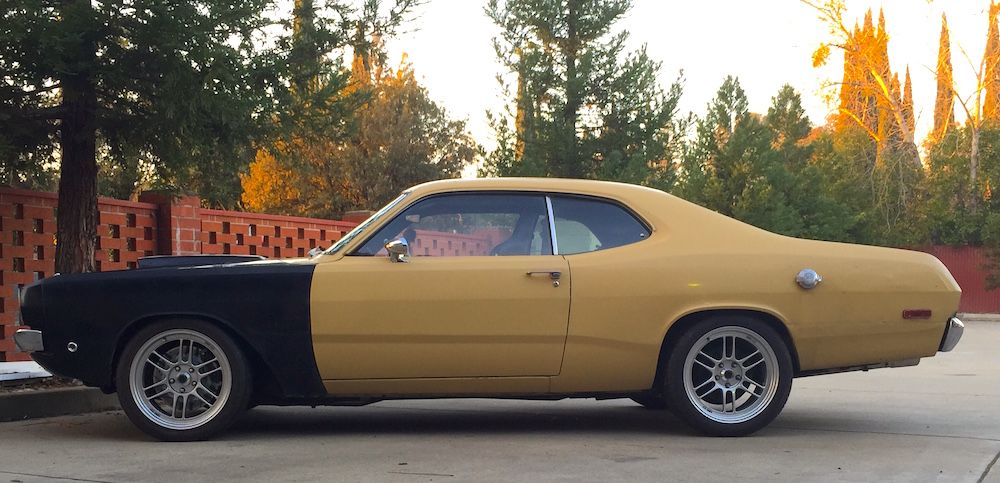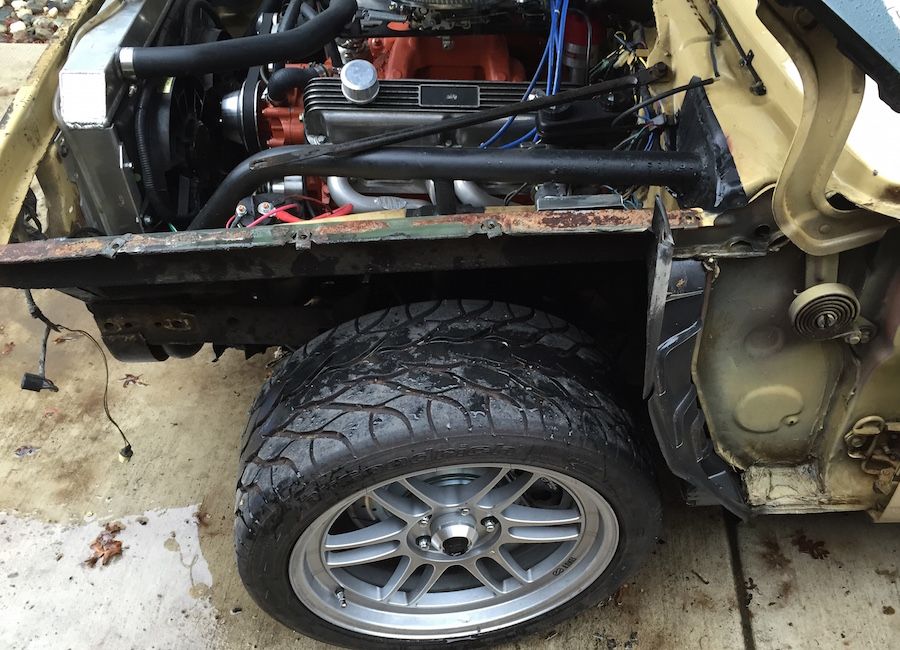drop spindles
Drop spindles are 100% unnecessary on a torsion bar suspension. By far one of the greatest advantages of the torsion bar design is the ability to raise and lower the ride height.
I used to run the 2" drop spindles on my Challenger. It was the one of the first things I did to the car, and before I had a good handle on how the torsion bar suspension works. I removed them, put the stock spindles back in, and lowered my car to the EXACT same ride height using just the torsion bar adjusters. There are two things you do have to take into account when you lower using the torsion bars though. First, you lose suspension travel. That's a problem only if you don't increase the size of your torsion bars. If you do increase the size of your torsion bars, you don't need, and won't use, all of that travel. Second, as you lower the car with the torsion bars the negative camber on the car will increase, which is good, but you lose caster. The best way to get that back is with a set of Moog offset UCA bushings, #7103, or a set of tubular UCA's with additional caster already built in.
My Challenger sits with the wheel arches 25" off the pavement. I swapped out the stock LCA bumpstops for more clearance. The stock bump stops were designed to be "used" as part of the suspension, that's why they're tall and progressive, they actually add spring rate as the bumpstops hit the frame and compress. That's fine if you want to run a really soft spring rate like the factory did, but if you increase the size of your torsion bar to have the spring rate that you want, you don't want or need to use the bumpstops. So they can be swapped out for poly "button" style bumpstops, which allow for more clearance. I have about 15/16" from my bumpstops to my frame on my Challenger, and I almost never hit them with the 1.12" torsion bars I have.
My Duster has even less clearance. I've lowered it down to 24 7/8" from the wheel arch to the pavement. The bumpstops I use are 3/8" tall, (http://www.summitracing.com/parts/ens-9-9132g/overview/) and even using those I only have about 7/8" travel from the LCA to the bumpstop. I've never hit them. Again, that's with a 1.12" torsion bar, which is a 300 lb/in wheel rate. So probably stiffer than most folks want to go. But, even with a 1.03" bar, you need less than half the amount of travel as a stock torsion bar. Keep in mind the stock wheel rate was 90-110 lb/in on these cars. A 1.03" bar has a wheel rate in the 220 lb/in range, more than DOUBLE the stock wheel rate. Which means, less than half the suspension travel as the stock bars.
The drop spindles also increase bump steer, and raise your roll center for a given ride height compared to lowering with the torsion bars. Compared to lowering with the torsion bars, when you lower the car 2" with the drop spindles your UCA's and LCA's remain at the same angle, and your steering point is moved away from your wheel center. When you lower with the torsion bars, the angle of the UCA's and LCA's change. When the UCA's are parallel to the ground, your camber curve is entirely favorable. And upward deflection of the UCA adds negative camber to the wheel, which improves handling. The roll center is also quite low at that point.
So, instead of spending $500 on drop spindles, buy a set of torsion bars and offset bushings and do it right for less.
This is how my Duster was sitting when the wheel arch was at 25 1/8". I've lowered it another 1/4" since then, and may go a little lower before I'm done. Stock spindles, stock LCA's, and the 3/8" bumpstop I linked earlier. I do have tubular UCA's to clear my 18x9" rims in the front. My ride height will end up being dictated by the 275/35/18's I have up front, I won't be able to lower it as much as vntnd to tuck the wheels because the tires are too close the fenders. I'd also probably run out of clearance to the top of the inner fender, with 25.7" tall tires I don't have much vertical clearance.


Drop spindles are 100% unnecessary on a torsion bar suspension. By far one of the greatest advantages of the torsion bar design is the ability to raise and lower the ride height.
I used to run the 2" drop spindles on my Challenger. It was the one of the first things I did to the car, and before I had a good handle on how the torsion bar suspension works. I removed them, put the stock spindles back in, and lowered my car to the EXACT same ride height using just the torsion bar adjusters. There are two things you do have to take into account when you lower using the torsion bars though. First, you lose suspension travel. That's a problem only if you don't increase the size of your torsion bars. If you do increase the size of your torsion bars, you don't need, and won't use, all of that travel. Second, as you lower the car with the torsion bars the negative camber on the car will increase, which is good, but you lose caster. The best way to get that back is with a set of Moog offset UCA bushings, #7103, or a set of tubular UCA's with additional caster already built in.
My Challenger sits with the wheel arches 25" off the pavement. I swapped out the stock LCA bumpstops for more clearance. The stock bump stops were designed to be "used" as part of the suspension, that's why they're tall and progressive, they actually add spring rate as the bumpstops hit the frame and compress. That's fine if you want to run a really soft spring rate like the factory did, but if you increase the size of your torsion bar to have the spring rate that you want, you don't want or need to use the bumpstops. So they can be swapped out for poly "button" style bumpstops, which allow for more clearance. I have about 15/16" from my bumpstops to my frame on my Challenger, and I almost never hit them with the 1.12" torsion bars I have.
My Duster has even less clearance. I've lowered it down to 24 7/8" from the wheel arch to the pavement. The bumpstops I use are 3/8" tall, (http://www.summitracing.com/parts/ens-9-9132g/overview/) and even using those I only have about 7/8" travel from the LCA to the bumpstop. I've never hit them. Again, that's with a 1.12" torsion bar, which is a 300 lb/in wheel rate. So probably stiffer than most folks want to go. But, even with a 1.03" bar, you need less than half the amount of travel as a stock torsion bar. Keep in mind the stock wheel rate was 90-110 lb/in on these cars. A 1.03" bar has a wheel rate in the 220 lb/in range, more than DOUBLE the stock wheel rate. Which means, less than half the suspension travel as the stock bars.
The drop spindles also increase bump steer, and raise your roll center for a given ride height compared to lowering with the torsion bars. Compared to lowering with the torsion bars, when you lower the car 2" with the drop spindles your UCA's and LCA's remain at the same angle, and your steering point is moved away from your wheel center. When you lower with the torsion bars, the angle of the UCA's and LCA's change. When the UCA's are parallel to the ground, your camber curve is entirely favorable. And upward deflection of the UCA adds negative camber to the wheel, which improves handling. The roll center is also quite low at that point.
So, instead of spending $500 on drop spindles, buy a set of torsion bars and offset bushings and do it right for less.
This is how my Duster was sitting when the wheel arch was at 25 1/8". I've lowered it another 1/4" since then, and may go a little lower before I'm done. Stock spindles, stock LCA's, and the 3/8" bumpstop I linked earlier. I do have tubular UCA's to clear my 18x9" rims in the front. My ride height will end up being dictated by the 275/35/18's I have up front, I won't be able to lower it as much as vntnd to tuck the wheels because the tires are too close the fenders. I'd also probably run out of clearance to the top of the inner fender, with 25.7" tall tires I don't have much vertical clearance.

